Ferrari reveals SF90 Stradale hybrid 31 | 05 | 2019
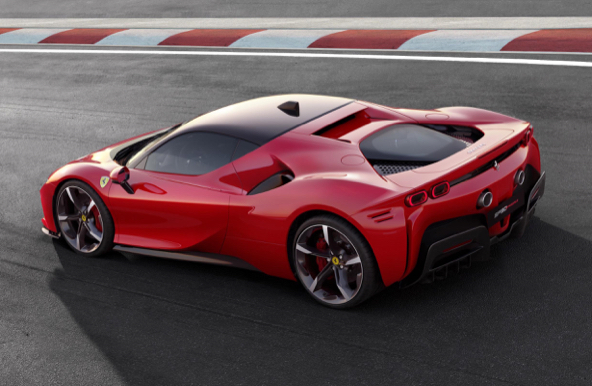
FERRARI HAS LAUNCHED a new chapter in its history with the introduction of its first series production PHEV (Plug-in Hybrid Electric Vehicle), the SF90 Stradale. The new car is positioned as a new halo model for the current line-up. (Related: Niki Lauda: 1949-2019)
The name SF90 Stradale references Ferrari’s 90th anniversary in F1, which the brand celebrates this year, and is taken from the current SF90 Formula One race car. ‘Stradale’ means street in Italian. (Related: Exclusive interview with F1 boss Ross Brawn)
Core to the car is Ferrari’s mid-mounted turbocharged V8, which has been mated to three electric motors fed by a small 7.9kWh battery located behind the rear bulkhead. The combination delivers a whopping 986bhp; plus there’s 800Nm torque.
That means the SF90 Stradale will cover 0-62mph in 2.5 seconds and carry on to a top speed of 211mph.
Ferrari has totally redeveloped the turbocharged 3.9-litre V8 unit seen elsewhere in the range. Bore increases take it up to 4.0-litres, the intake and exhaust systems, along with the turbocharger have all been redesigned. Ferrari’s most powerful V8 ever now produces 769bhp on its own. (Related: Ferrari's one-off P80/C track car)
in addition, the three electric motors — one runs on the driveshaft from the engine to a brand new, eight-speed dual-clutch transmission, while the other two drive the front axle making the car four-wheel drive — are capable of delivering 217bhp.
Ferrari says it’s possible to drive the SF90 Stradale on battery power only for 15.5 miles when the car is toggled into eDrive via the wheel mounted Manettino switch.
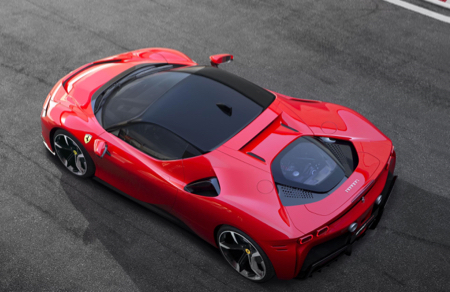
FUNCTION MODES:
Thanks to an additional steering wheel-mounted selector, dubbed the eManettino (analogous to the Manettino which is used to set the electronic vehicle dynamics modes), the driver can choose from four different power unit management modes:
eDrive: The internal combustion engine remains off and traction is entrusted entirely to the electric front axle. Starting with a fully charged battery, the car can cover up to 15.5 miles in this mode. This mode is ideal for city centre driving or any other situation in which the driver wishes to eliminate the sound of the Ferrari V8.
Hybrid: This is the default setting when the car is turned on, in which the power flows are managed to optimise the overall efficiency of the system. The control logic autonomously decides whether to keep the internal combustion engine running or turn it off. If it is on, the internal combustion engine can run at maximum power thus guaranteeing powerful performance whenever the driver requires.
Performance: Unlike ‘Hybrid’, this mode keeps the ICE running because the priority is more on charging the battery than on efficiency. This guarantees that power is instantly and fully available when required. This mode is best suited to situations in which driving pleasure and fun behind the wheel are the main focus.
Qualify: This mode allows the system to achieve maximum power output by allowing the electric motors to work at their maximum potential (162kW). The control logic prioritises performance over battery charging.
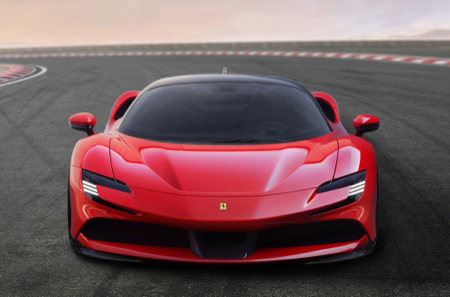
DESIGN:
Ferrari says the SF90 Stradale is the most advanced car in the range from a point of view of performance and technology. The definition of the exterior styling was inspired by that principle: to create a forward-looking, innovative design that transmits the car’s mission as an extreme sports car – Ferrari’s first series production supercar.
Ferrari Design has thus completely revisited the proportions of the front, central and rear volumes in a radical evolution of the forms of Ferrari’s mid-rear-engined production berlinettas of the last twenty years. (Related: Ferrari launches new 710bhp F8 Tributo)
The SF90 Stradale slots in between the mid-rear-engined coupés, today represented by the F8 Tributo, and supercars of the likes of LaFerrari, and is the new standard-bearer for hyper-technological extreme cars brimming with future-forward content.
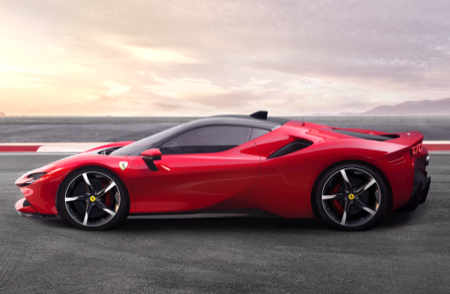
EXTERIOR:
The SF90 Stradale’s architecture, in which the cabin is located ahead of the mid-mounted engine, provided Flavio Manzoni and his team of designers at the Ferrari Styling Centre, with the ideal platform on which to craft a genuine supercar of impeccable proportions.
More compact overhangs (the rear one is shorter than the front one) and the frontward-shift of the cabin have created a cab-forward-type architecture which emphasises the fact that the engine is mid-mounted. A very low centre of gravity has also allowed the designers to lower the cabin area by 20mm. Combined with a more curved windshield, slender A-posts and a wide track, this creates a beautifully proportioned car with sleeker volumes. (Related: Unique Scotland Blue Ferrari 812)
The compact bubble-shaped cabin has an aeronautical cockpit feel and the fact it has been shifted so far forward is further emphasised by the geometry of the two body-coloured rear flying buttresses that enclose the rear.
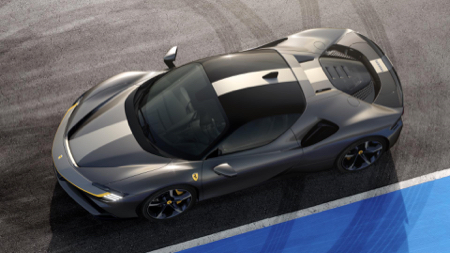
Another signature solution is the headlights which hail a move away from the L-shaped look, to a slender slit design integrated with the brake air intakes resulting in a characteristic C-shape which lends the front of the car an original and futuristic appeal.
In a first for a Ferrari, the SF90 Stradale uses matrix LED headlight technology to improve visibility in all driving conditions thanks to active beam control.
The rear of the car is dominated by high exhaust pipes which are the result of optimisation of the exhaust line layout. Because the power- train is significantly lower in the car than in the past, the designers were also able to lower the car’s tail. Another deviation from the styling typical of past berlinettas is the way the profile of the rear screen no longer follows the line from the roof to the rear bumper. This element of styling discontinuity is evidenced by the separation of the screen from the cooling grille.
The tail lights have also evolved quite radically from Ferrari’s iconic round shape. The eye-catching, more horizontal luminous rings create a more horizontal perception of the tail lights which in turn visually lowers the height of the tail.
INTERIOR:
Ferrari says the interior of the SP90 Straddle is ‘radical’. The very explicit aim was to create a cockpit that ushered in an entirely new design direction, the effects of which would carry over into Ferrari’s entire future range.
The designers have taken a futuristic approach to the interface concept with a strong focus on creating a wraparound aeronautically-inspired cockpit with particular emphasis on instruments.
In a first for a Ferrari, the central instrument cluster comprises a single 16in digital HD screen which curves towards the driver to make it easier to read and to emphasise the F1-style wrap-around cockpit effect. This is the first time this type of screen has been adopted in a production car.
When the engine and motors are off, the onboard instruments go black lending the cockpit a wonderfully sleek, minimalist look. In line with Ferrari tradition, the default screen is dominated by a large circular rev counter which, however, this time is framed by the battery charge indicator. The navigation screen is on one side of the rev counter with the audio control one on the other.
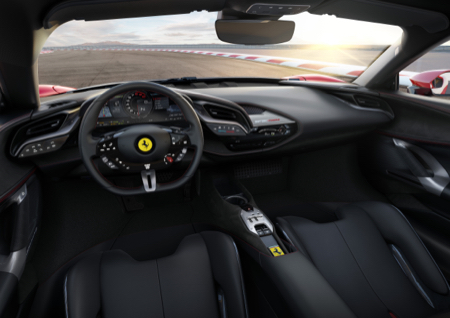
The “hands-on-the-wheel” philosophy has consistently driven the development of the human-machine interface in every Ferrari F1 car and its subsequent gradual transfer to its road-going sports cars. The SF90 Stradale’s steering wheel completes that transfer process from the competition world and also ushers in a new era by introducing a series of touch commands that allow the driver to control virtually every aspect of the car without ever taking their hands off the wheel.
The traditional controls include the now-classic steering-wheel mounted headlight control, windscreen wipers, indicators and the Manettino for driving modes.
Of the new touch controls, the compact but functional pad on the right-hand spoke allows the driver to navigate the central cluster screens, while voice and cruise controls are on the left-hand spoke. Also noteworthy is the adoption of a rotary switch for cruise control, a solution derived directly from the Formula 1 car. In the bottom left section of the central area, there are four buttons the driver uses to select the power unit use mode.
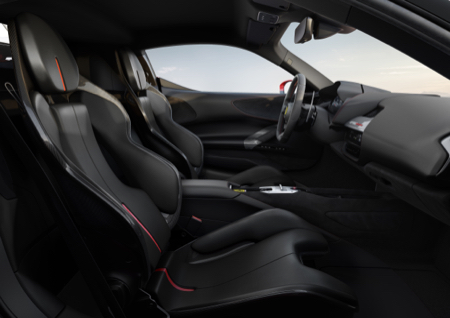
The Head Up Display is another part of the innovative HMI and allows various data to be projected onto the windshield within the driver’s field of vision so that their attention is not distracted from driving.
From a creative perspective, the SF90 Stradale interface project gave the Ferrari Style Centre’s designers the opportunity to interpret the screens in the cabin as a canvas on which all the car’s functions and controls could be represented. The screen graphics on the SF90 Stradale were also designed to create a 3D effect which is particularly striking during transitions, such as when the instrument panel is turned on or when swapping from one screen to the next.
Alongside the new-concept HMI, another major theme tackled in the cabin was the tunnel area interface. The F1 controls on the “bridge” are probably the most iconic of the Ferraris of recent generations. These have been completely redesigned and set into a modern metal plate which references an equally iconic feature from the past: the classic gear lever gate.
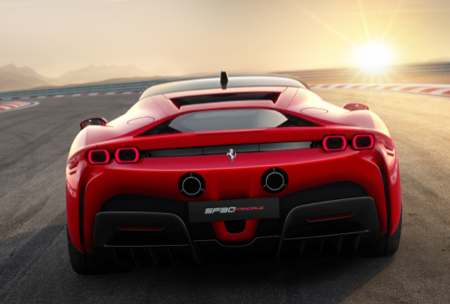
TECHNICAL SPECIFICATIONS
Internal combustion engine:
Type V8 - 90° - turbo – dry sump
Total displacement 3990 cc
Maximum power output* 574 kW (780 cv) @ 7500 rpm
Max torque 800 Nm @ 6000 rpm
Specific power output 195 cv/l
Max. engine speed 8000 rpm
Compression ratio 9.5:1
Hybrid system:
Maximum power electric motors 162kW (220 hp)
Battery capacity 7.9kWh
Max. range under electric power 15.5 miles
Dimensions and weight:
Length 4710mm
Width 1972mm
Height 1186mm
Wheelbase 2650mm
Front track 1679mm
Rear track 1652mm
Dry weight 1570kg
Weight distribution 45% front - 55% rear
Boot capacity 74L
Rear shelf capacity 20L
Fuel tank capacity 68L (2 reserve)
Tyres
:
Front 255/35 ZR 20 J9.5
Rear 315/30 ZR 20 J11.5
Brakes
:
Front 398 x 223 x 38mm
Rear 360 x 233 x 32mm
Transmission and gearbox:
8-speed, F1 dual-clutch transmission
Electronic controls eSSC: E4WD (eTC, eDiff3), SCME-Frs, FDE2.0, EPS, high performance ABS/EBD with energy recovery
Performance
:
Maximum speed 211mph
0-62mph 2.5s
0-124mph 6.7s
62-0mph <29.5m
Dry weight/power 1.57kg/hp
Laptime at Fiorano 79s
Related: Ferrari unveils 488 Pista Spider
Keep up-to-date with all the latest news by following us on twitter.com/Scotcars
Jim McGill